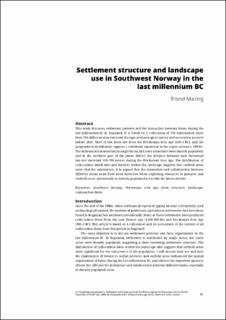Settlement structure and landscape use in Southwest Norway in the last millennium BC
Chapter
Published version
Permanent lenke
https://hdl.handle.net/11250/3103913Utgivelsesdato
2023Metadata
Vis full innførselSamlinger
- Articles (AmS) [145]
- Publikasjoner fra CRIStin [4377]
Originalversjon
Meling, T. (2023) Settlement structure and landscape use in Southwest Norway in the last millennium BC. In Complexity and dynamics. Settlement and landscape from the Bronze Age to the Renaissance in the Nordic Countries (1700 BC–AD 1600), M. Ødegaard and I. Ystgaard (eds.), pp. 41-52. Sidestone Press, Leiden.Sammendrag
This study discusses settlement patterns and the interaction between farms during the last millennium BC in Rogaland. It is based on a collocation of 792 radiocarbon dates from 250 different sites retrieved through archaeological survey and excavation projects before 2020. Most of the dates are from the Pre-Roman Iron Age (500–1 BC), and the geographical distribution suggests a settlement expansion in the region around c. 500 BC. The settlement is dominated by single farms, but some areas have been densely populated, and in the northern part of the Jæren district the distance between each farmstead has not exceeded 500–700 metres during the Pre-Roman Iron Age. The distribution of radiocarbon dated sites and features within the landscape suggests that outfield areas were vital for subsistence. It is argued that the interaction and collaboration between different farms must have been extensive when exploiting resources in pastures and outfield areas, particularly in densely populated areas like the Jæren district.
